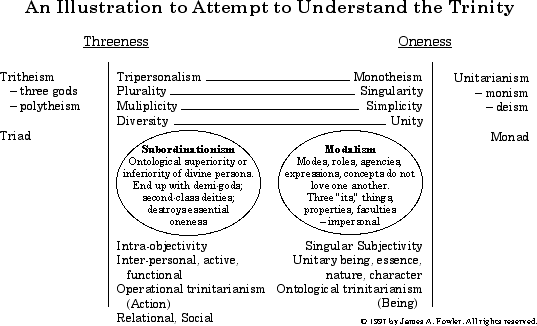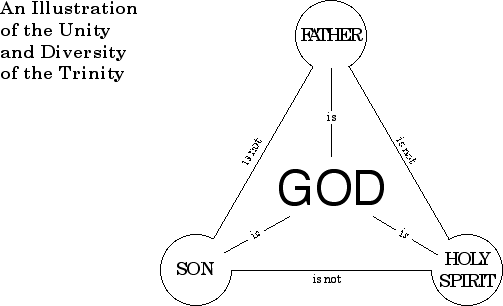©
1999 James A. Fowler
You are free to download
this outline provided it remains intact without alteration. You
are also free to transmit this outline electronically provided
that you do so in its entirety with proper citation of authorship
included.
TRINITY
I. Biblical references to "trinity"
A. There are no references to the
word "trinity" in the Bible.
B. Development of the word "trinity"
in reference to God.
1. Greek
word trias
a.
Means "threefold" or "threesome"
b.
Used by Theophilus of Antioch c. 175 A.D.
2. Latin
word trinitas
a.
tri means three; unitas means unity
b.
Used by Tertullian c. 210 A.D.
c.
Root of English word "trinity"
3. The
word was employed in attempt to correlate and integrate the revelation
of God as
singular,
yet functionally diverse in three distinct personages.
a.
necessity of correlating oneness and threeness of God
b.
concept of "trinity" inherent in Scripture "in
solution"
C. References to the oneness or unity
of God
1. Old
Testament
Deut.
6:4 - "The Lord our God, the Lord is one!"
Deut.
32:39 - "I am He, and there is no god besides Me"
Isa.
43:10 - "Before Me there was no God formed, and there will
be none after Me"
Isa.
46:9 - "I am God and there is no other; there is no one
like Me"
2. New
Testament
I
Cor. 8:4-6 - "there is no God but one. ...there is but one
God, the Father...; and one Lord,
Jesus
Christ..."
Gal.
3:20 - "God is only one"
D. References to the diversity of God
1. Old
Testament
Gen.
1:1 - "In the beginning God (Elohim - plural) created..."
Gen.
1:26 - "Let Us (plural) make man in Our (plural) image"
Isa.
6:8 - "Who will go for Us (plural)?"
Isa.
9:6 - (Messianic) "Mighty God, Eternal Father, Prince of
Peace"
2. New
Testament
Matt.
3:16,17 - "being baptized, Jesus...saw the Spirit of God
descending...and a voice,
saying,
'This is My beloved Son...'"
Matt.
28:19 - "baptizing them in the name of the Father and the
Son and the Holy Spirit"
II
Cor. 13:14 - "the grace of the Lord Jesus Christ, and the
love of God, and the fellowship
of
the Holy Spirit, be with you all"
Gal.
4:6 - "God sent forth the Spirit of His Son into our hearts..."
Eph.
4:4-6 - "one Spirit...one Lord...one God and Father of all..."
I
Pet. 1:2 - "foreknowledge of God the Father, by the sanctifying
work of the Spirit, that
you
may obey Jesus Christ..."
I
Jn. 5:7 (KJV) - (without adequate MSS evidence; interpolation)
a.
Father as God
Jn.
6:27 - "the Father, God, has set His seal"
Eph.
4:6 - "one God and Father"
I
Pet. 1:2 - "God the Father..."
b.
Son as God - (cf. I Jn. 5:20; Phil. 2:6
Jn.
1:1 - "the Word was God"
Jn.
20:28 - "My Lord and my God"
Titus
2:13 - "our great God and Savior, Christ Jesus"
Heb.
1:8 - "of the Son, 'Thy throne, O God, is forever..."
II
Pet. 1:1 - "God and Savior, Jesus Christ"
c.
Holy Spirit as God
Acts
5:3,4 - "lie to Holy Spirit...you have lied to God"
Rom.
8:9 - "the Spirit...Spirit of God...Spirit of Christ
I
Cor. 6:11 - "the Spirit of our God"
II
Cor. 3:17,18 - "the Lord is the Spirit"
II. A brief history of Christian discussion concerning
the "trinity"
A. Justin Martyr (100-165) - while
arguing for monotheism, refers to Jesus as "a second God
in number"
B. Theophilus of Antioch (c. 175) - first
to use Greek trias for "threesomeness" of God.
C. Tertullian (160-220) - first to use
Latin terms: trinitas explained as 3 personae in
one
substantia.
D. Origen (c. 182-251) - subordinated
Jesus and Spirit to the Father; Father is God in Himself,
Son is
image of Father, Spirit is image of Son.
E. Arius (c. 250-336) - Son brought into
being by God, and thus made God.
F. Athanasius (296-373) - first to employ
Greek homoousion as explanation of trinity.
G. Council of Nicea (325) - accepted
Athanasius' homoousion explanation as orthodox
Christian
teaching. Some wanted homoiousion.
H. Cappadocian theologians (4th century),
Basil, Gregory of Nyssa, Gregory of Nazianzus -
Settled
on 3 hypostaseis in 1 ousia.
I. Augustine (354-430) - Three persons
in 1 nature or essence. Many psychological analogies
(ex. mind,
knowledge, love)
J. Eastern Orthodox Church (1054) - rejected
filoque concept of Spirit generated from Father
"and
the Son"; division from Western Latin Church
K. Richard of St. Victor (c. 1120-1173)
- God as love demands a plurality of persons.
L. Thomas Aquinas (1225-1274) - three
subsistences in one God.
M. John Calvin (1509-1564) - made more
distinction between Son and Spirit.
N. Karl Barth (1886-1968) - three modes
of being in one God, who is both I and Thou.
III. Issues of consideration concerning the "trinity"
A. Identifying the Oneness
1. Being
2. Essence
3. Substance
4. Nature
5. Reality
6. Person
7. Godhead
B. Identifying the Threeness
1. Persons
a.
psychologically - personalities, self-conscious beings
b.
sociologically - interrelational, interpersonal
c.
distinct agents
2. Individualities
3. Identities
4. Roles
of activity
5. Modes
of expression
6. Entities
7. Emanations
C. Interrelational factors of threeness
1. Father,
Son, Holy Spirit
a.
paternity, filiation, procession
b.
unbegotten, begotten, procession
2. Priority
and subordination
a.
in relational function, but not essential being
b.
eternality of such
3. Eternal
interpersonal relations
a.
God is Person
b.
God is Love
c.
God is Faithful
d.
Dynamic Being
e.
Fellowship
D. The tension or dialectic between
1. Oneness
and threeness
2. Unity
and diversity
3. Indivisibility
and distinctness
4. Coinherence
and community
E. Avoidance of extremes
1. Unitarianism,
monad
2. Tritheism,
polytheism
3. Modalism,
Monarchianism
4. Subordinationism
F. Inadequacy of all human analogies
1. father,
son, husband
2. water:
liquid, gas, solid
3. music:
3 notes, 1 chord
4. light:
3 bulbs, 1 lumination
5. atom:
neutron, electron, proton
6. space,
matter, time
a.
space: length, width, height
b.
matter: energy, motion, phenomenon
c.
time: past, present, future
7. source,
manifestation, meaning
8. cause,
event, consequence
9. spirit,
soul, body
G. Necessary balance
1. Ontological
trinitarianism
2. Operational
trinitarianism
a.
relational trinitarianism
b.
administrative trinitarianism
c.
economic trinitarianism
d.
sociological trinitarianism
e.
ergonomic trinitarianism
f.
synergistic trinitarianism
g.
functional trinitarianism
IV. Implications of attempting to understand the "trinity"
of God
A. Correlates with age old philosophical
question of one and many
1. Emphasis
on one
a.
monism
b.
unity
c.
singularity
d.
simplicity
2. Emphasis
on many
a.
complexity
b.
diversity
c.
relativity
d.
random
3. Einstein's
"theory of relativity" and "unified field theory"
were attempts to explain that the
diversities
relate to a constant and a singularity.
B. Three alternatives of response to
Scriptural teaching of oneness/threeness
1. Reject
as incompatible with human reason - absurdity
2. Reduce
to human reason - emphasize oneness or threeness
3. Accept
the revelation of God - hold in balance/tension of dialectic
or antinomy.
a.
Natural reason will never arrive at trinitarian understanding
of God.
b.
Must accept God in the manner He has revealed Himself
c.
Failure to do so is deification of human reason
C. Centrality of trinitarian understanding
to all Christian teaching
1. Pervades
every doctrinal category
a.
Christology
(1)
Incarnation - Jesus as God-man
(2)
Redemptive efficacy
b.
Pneumatology
c.
Soteriology
d.
Sanctification
e.
Ecclesiology
2. Necessity
of trinitarian assent for Christian belief
a.
God has revealed Himself in His Son, by the Spirit
(1)
He cannot be known in any other way, except through the Son,
by the Spirit -
Jn
14:6,7
(2)
The gospel of salvation/sanctification requires the persons and
work of Father, Son,
and
Holy Spirit
b.
Must allow for latitude of differentiation in human struggle
to understand and express
the
tension between oneness and threeness
(1)
Can never adequately express in human thought or words
(2)
Point out dangers and fallacies of overemphases
3. Gregory
of Nazianzen (c. 329-389 A.D.) - "I cannot think of the
One, but I am
immediately
surrounded with the glory of the Three; nor can I clearly discover
the Three,
but
I am suddenly carried back to the One."
|

















